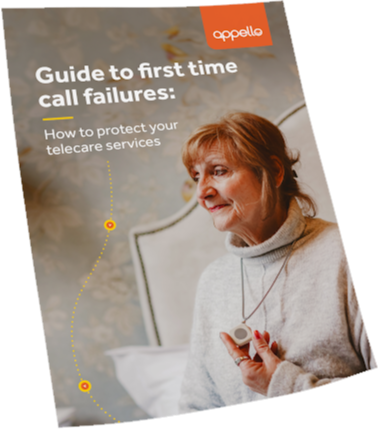There’s been much discussion about digital telecare over the last few years but some housing providers still have a question mark over the right time to upgrade their services.
With work on the digital switchover in progress, how important is it to prioritise the move from analogue to digital – and what are the risks of delaying this?
As the Department of Health & Social Care comments: “The UK telecommunications sector’s imminent switch to digital raises risks for users of the telecare services run by local authorities, housing associations, the third sector and commercial organisations.”
Despite this, we know there’s still a long way to go before the majority of telecare services are fully digital.
Our digital telecare briefing in 2022 found a number of reasons for this. While many housing providers recognise the advantages of digital, there are budget and logistical considerations, alongside factors such as mixed messages from suppliers and an impulse to wait for the very latest version of the technology.
But adopting a ‘wait and see’ approach is an increasingly risky tactic for both your organisation and your customers.
The safety of crucial telecare services is the central concern. Alongside this, it’s also important to be aware how inaction now may have a range of implications for your business further down the line.
A rise in call failures – the risks of analogue telecare in a digital world
There are potential compatibility issues when operating analogue telecare equipment over a digital network, as analogue and digital systems use different protocols to communicate (essentially ‘speaking’ different languages). This means signals from analogue telecare equipment can be misinterpreted by the digital network, resulting in distorted calls, a delay in connecting a call or even complete call failure.
This is clearly a big risk to what are life-saving services.
As the digital network is rolled out across the country, we’re starting to see the reality of this, with the stats showing an increase in call failure rates. Recent research reported “failure rates across all service users were typically around 5%”, while independent testing by the TSA concluded there is a “variation in performance of analogue devices across… digital networks”, with the results highlighting “a significant proportion (of TEC devices) that either function intermittently – or not at all”.
This is not a surprise. Various industry and public bodies have previously flagged concerns regarding the use of analogue telecare equipment across the digital network.
What are the risks for housing providers?
The bottom line is the reliability and safety of your telecare services is likely to decline as work continues on the digital switchover.
This poses a number of risks to your organisation, including:
1. Operational risks
Any increase in call failures will lead to questions from your residents, as they will want to understand why they’re experiencing problems with their calls. This will put pressure on your staff on site, affecting productivity as they spend more time managing these queries, reviewing the issues and liaising with suppliers to try to resolve these. (It’s also worth noting your staff may actually already be dealing with the impact of the digital switchover without realising this, judging by the reported increase in call failures described above.)
2. Reputational risks
Your customers may have limited knowledge about the digital switchover at the moment but this is likely to change, as publicity will ramp up as we get closer to the switchover ‘end date’ of 2025.
In fact, one of the key priorities identified by the government’s Telecare Stakeholder Action Plan is to communicate with telecare users in order to “increase awareness and understanding of the switchover”.
With more information in the mainstream, your customers may start to worry about the fact they’re still using equipment they’ve been informed is no longer compliant. In addition, with a wealth of sources stating both the safety concerns and the recommended actions, they may also question why their housing provider has not yet upgraded such a vital service.
3. Business risks
Alongside being the safer option, digital telecare is a huge step up in so many ways, providing the scope to transform your services and work more effectively. As the Local Government Association explains, the “opportunity to gather and use data from digital solutions is the key difference”.
By delaying your digital upgrade, you’re missing the chance to put yourself ahead – and risking handing your competitors the advantage instead, as they reap the rewards of their own new digital systems.
4. Strategic risks
There are risks in waiting too long to upgrade to digital telecare. We have previously highlighted several challenges facing both the telecare industry and telecare service providers as we get closer to the final stages of the digital switchover.
An influx in demand for digital telecare could see housing providers competing to ensure their services can meet the requirements of a digital network. This may result in procurement, supply chain and industry capacity issues, which in turn will lead to higher costs and less flexibility and choice for your organisation.
5. Safety risks
While it’s important to be aware of the wider implications above, the welfare of your customers will of course be your prime concern.
The most significant risk of delaying a move from analogue to digital telecare is to the safety of your customers.
As the Digital Office Scotland warns in its National Briefing Document: “Inaction on switching to digital telecare could lead to dangerous failures of essential services and will put the support given to vulnerable individuals at risk.”
How to avoid the risks to your telecare services
The truth is the only way to mitigate the risks to your customers and your organisation is to meet the challenge of the digital switchover head on.
Planning your next steps now ensures the safety and reliability of your telecare services both today and in the future, so you can continue to support the people who rely on these.
We’ve put together a number of resources to help you on your digital journey, including:
You can find more details on the issue of first time call failures in our latest guide, which is available to download now

Talk to us to discuss your requirements and find out about our cost-effective and future proof digital solutions.


.png?width=700&name=Blog%20Thumbnails%20(1).png)
